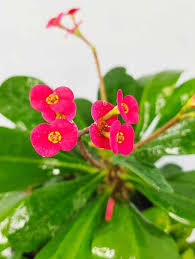Diverse Euphorbia Species in the Euphorbiaceae Family
Explore the remarkable diversity of the Euphorbia genus, part of the Euphorbiaceae family, featuring over 2,000 plant species including succulents, shrubs, and trees. Discover their ecological importance in arid landscapes and their role in global biodiversity.
5/23/20254 min read


Introduction to Euphorbia Species
The genus Euphorbia, belonging to the family Euphorbiaceae, comprises a vast array of plant species that showcase remarkable diversity. With over 2,000 known species, Euphorbia can be found in various forms, including succulents, shrubs, and trees, demonstrating a wide range of morphological variations. This extensive variety not only enriches the global biodiversity but also plays a pivotal role in ecosystems, particularly in challenging environments such as the arid landscapes of Dubai.
Particularly significant is the adaptation of Euphorbia species to desert conditions. These plants have evolved unique physiological and morphological traits that enable them to thrive in extreme temperatures and limited water availability. Many Euphorbia species exhibit succulent characteristics, allowing them to store water in specialized tissues, thereby minimizing water loss. Additionally, their ability to absorb sunlight efficiently through reduced leaf surface area helps facilitate photosynthesis while conserving moisture—a crucial adaptation for survival in a desert climate.
In Dubai, Euphorbia serves essential ecological functions. As a source of food and shelter, these plants contribute to the sustenance of local wildlife, including various insect species and small mammals. Moreover, their presence helps stabilize the soil, reducing erosion, and they can play a crucial role in preventing desertification. The ecological significance of Euphorbia extends further, as its ability to thrive in inhospitable environments could provide insights into sustainable practices for landscape management in arid regions.
Overall, the Euphorbia genus exemplifies a compelling intersection between resilience, adaptability, and ecological importance, making it a vital subject of study for botanists, ecologists, and horticulturists alike. Understanding the various species within this genus will not only enhance our appreciation for plant diversity but also inform conservation efforts and promote sustainable landscaping in arid landscapes like Dubai.
Common Euphorbia Species Found in Dubai
The Euphorbia genus comprises a diverse group of plants, and Dubai hosts several notable species that thrive in its arid climate. Among the most common Euphorbia species found in this region are Euphorbia tirucalli, Euphorbia milii, and Euphorbia ingens. Each of these species has unique characteristics that make them well-suited to the environment.
Euphorbia tirucalli, commonly known as the pencil cactus, is recognized for its distinctive cylindrical stems that resemble pencils. This succulent can reach heights of up to 10 meters and features a striking yellow latex sap that can be harmful if ingested. Its drought-tolerant nature allows it to flourish in rocky or sandy soils, often found in gardens and landscaping across the city.
Another prominent species is Euphorbia milii, also known as crown of thorns. This shrub is characterized by its thorny stems and clusters of vibrant, small flowers that bloom throughout the year. It typically grows to about 1 meter tall and prefers well-drained soils in full sun environments. The crown of thorns is not only valued for its ornamental qualities but also represents resilience, adapting well to arid conditions.
Lastly, Euphorbia ingens, or the African milk barrel, is a large succulent that can grow up to 5 meters high. Featuring a robust, columnar form with branches that shoot upwards, it often displays a captivating green hue. This species prefers rocky slopes and well-drained soils, making it a popular choice for xeriscaping projects in Dubai. Additionally, its unique structure offers excellent visual appeal, allowing it to stand out among other plants.
Understanding these common Euphorbia species helps both enthusiasts and researchers in identifying and appreciating the remarkable biodiversity found within Dubai’s gardens and landscapes.
Euphorbia Species Identification Tips
Identifying Euphorbia species can be a rewarding endeavor, especially for enthusiasts and botanists in Dubai. A systematic approach to visual identification is essential for accurate classification. The first distinguishing feature to consider is the leaf shape. Euphorbia leaves can vary significantly among species; some may be narrow and linear, while others are broad and lobed. Observing the arrangement of leaves on the stem, whether alternate, whorled, or opposite, can further aid in identification.
Another critical aspect to examine is the flower structure. Euphorbias produce distinctive flower heads known as cyathia, which consist of one or more small male flowers surrounding a central female flower. The characteristics of these cyathia—such as their size, color, and the presence or absence of bracts—are vital indicators for differentiating species. The intricate nature of their reproductive structures often reflects the diversity within the Euphorbia genus.
Growth habits also offer valuable clues in species identification. Some Euphorbia species are small, herbaceous plants, while others may be large and shrubby. Notably, understanding whether a species exhibits a mounding or spreading habit can enhance your identification skills. Additionally, seasonal variations must be taken into account; a species may display varying characteristics throughout the year due to environmental factors. For instance, flowers may bloom at different times depending on the climate, influencing sighting opportunities.
As a practical example, consider the Euphorbia milii, commonly known as crown of thorns, which features distinctive serrated leaves and striking flowers, often found in arid conditions. Familiarizing yourself with representative species, like this one, will provide a solid foundation for your identification efforts. Developing keen observational skills will not only enhance your knowledge but also enrich your experience in the diverse landscapes of Dubai.
The Role of Euphorbia in UAE's Biodiversity
Euphorbia species play a crucial role in the biodiversity of the United Arab Emirates, contributing significantly to the ecological equilibrium. These plants, which belong to the Euphorbiaceae family, exhibit a remarkable ability to thrive in arid environments, making them well-suited for the UAE’s harsh climatic conditions. Their adaptability allows them to offer essential habitat and food resources for a variety of local wildlife, thus enhancing the ecosystem's complexity and sustainability.
One of the most vital functions of Euphorbia species is their contribution to soil stabilization. Their extensive root systems help prevent soil erosion by binding the soil together, which is particularly important in the UAE's shifting sands and areas susceptible to desertification. This ability not only supports the local flora but also helps create a more stable environment for other organisms. By maintaining the integrity of the soil, Euphorbia promotes the growth of various plant species that rely on a solid foundation for their development.
Furthermore, these plants engage in intricate interactions with other flora and fauna within their habitat. For instance, many pollinators are attracted to the unique flowers of Euphorbia species, facilitating cross-pollination and enhancing genetic diversity among plants. The fruits of these plants also provide nourishment for various herbivores, thereby establishing an essential food chain link. Such relationships underscore the importance of preserving Euphorbia habitats, especially in the face of rapid urban expansion and climate change. Habitat degradation poses a significant threat to these native species, and ongoing conservation efforts are crucial to ensure their survival. Protecting these vital plants is not only essential for maintaining biodiversity but also for the overall health of ecosystems in the UAE. As urban developments continue to encroach on natural habitats, prioritizing the conservation of Euphorbia will play a vital role in sustaining the ecological integrity of the region.
